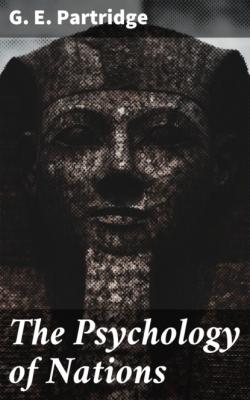ТОП просматриваемых книг сайта:
The Psychology of Nations. G. E. Partridge
Читать онлайн.Название The Psychology of Nations
Год выпуска 0
isbn 4057664627605
Автор произведения G. E. Partridge
Жанр Документальная литература
Издательство Bookwire
Social behavior is a development of all the fundamental tendencies of the organism. It has its roots both in the reproductive and the nutritional motives. These fundamental tendencies have issued phylogenetically in specific reactions that enter into the social life at all its levels, and in the life of the individual these reactions, expressing needs and desires, issue in highly complex moods, in which fundamental feelings are present but do not constitute the whole of the social moods. The individual does various specific things with reference to his fellows which are of the nature of instinctive reactions, but both in the phyletic development and the development in the individual, elements that enter into the modern social life as instincts have tended to lose their specific character, have become general or merely organic, have been transformed and have to some extent lost their original significance.
The motives of hunger, the reactions of the reproductive mechanisms, reactions to visual impressions and to sounds, warmth reactions, the huddling of fear, the influences of suggestion, susceptibility to all the stimuli of the social object enter into social feelings, and remain to some extent as instinctive reactions in the higher social processes. But we do not seem to find any general social instinct, or any specific herd instinct or any definite and broadly acting protective and aggressive instincts. As compared with some other views of the social feelings ours assumes in one way more and in another less of instinct in the social life. There is more instinct in the sense that more specific instinctive reactions are recognized in it, but less in assuming that these reactions are derivatives of primitive reactions of the organism, and also because they become transformed and fused and lose their original forms. They have come from common sources in organic life, we might say, and they meet again in the general moods which they help to create.
Conclusions
It is an important point to observe that most if not all of the specific instinctive reactions and feelings engendered in war, or occurring as an incitement to war, are capable of inducing ecstatic states. There are several of these movements and states, each of which can become, so to speak, a foundation for the development of ecstasy. Combat may and must do this, and probably war could never be carried on at all unless danger and death had qualities which arouse ecstatic moods. There is a joy in fighting, in killing, and in the tumult of battle that becomes one of the most important of military assets, and is one of the main elements of morale in the field. This capacity of human nature to make over that which is intrinsically painful into the pleasurable is one of the paradoxes of human life to be explained and taken into account in the study of the psychology of war. Fear itself may induce an ecstasy, both in the individual, as we know from many reported cases from the late war, and as a social mood in which the fear contributes a quality of intensity and ferocity to patriotism. The gambling mood, which is in part a play with fear, is another ecstatic reaction seen in war, and it is often the means of clearing the way, so to speak, for free and uninhibited action.
Of course all the purely æsthetic elements in the social life have this effect of arousing exalted moods, and indeed that is precisely their function. All social impulses tend in this same direction, and there is induced in all intense social states an intoxication mood. In these social states, the reproductive motive is often clearly discernible, but partly by common consent and convention, and partly because of the composite and fused form of impulses in the social mood, robbed of its specific reactions and converted into a new product, regarded both as conduct and as feeling.
Конец ознакомительного фрагмента.
Текст предоставлен ООО «ЛитРес».
Прочитайте эту книгу целиком, купив полную легальную версию на ЛитРес.
Безопасно оплатить книгу можно банковской картой Visa, MasterCard, Maestro, со счета мобильного телефона, с платежного терминала, в салоне МТС или Связной, через PayPal, WebMoney, Яндекс.Деньги, QIWI Кошелек, бонусными картами или другим удобным Вам способом.

